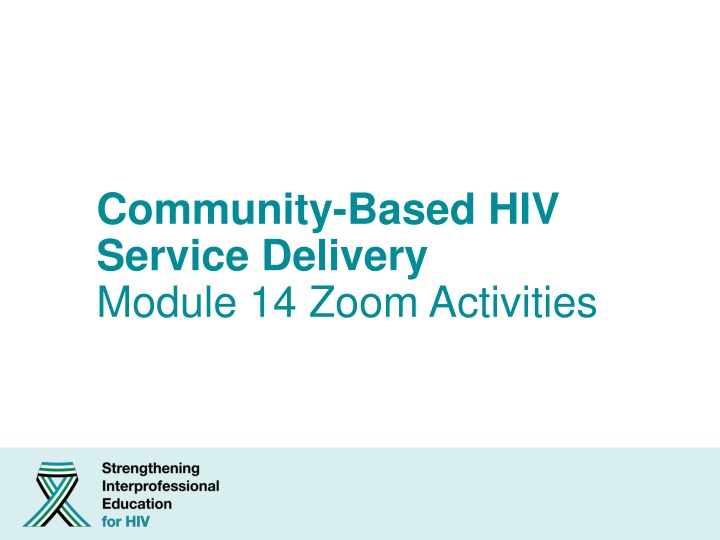
Effective Strategies for Community-Based HIV Service Delivery
Explore challenges in delivering high-quality care in HIV service delivery through small group discussions, breakout sessions, and reflection on implementing optimal care for patients like Kwabena. Compare and contrast community-based HIV service delivery models to enhance understanding and develop sustainable interventions for patient care.
Download Presentation

Please find below an Image/Link to download the presentation.
The content on the website is provided AS IS for your information and personal use only. It may not be sold, licensed, or shared on other websites without obtaining consent from the author. If you encounter any issues during the download, it is possible that the publisher has removed the file from their server.
You are allowed to download the files provided on this website for personal or commercial use, subject to the condition that they are used lawfully. All files are the property of their respective owners.
The content on the website is provided AS IS for your information and personal use only. It may not be sold, licensed, or shared on other websites without obtaining consent from the author.
E N D
Presentation Transcript
Community-Based HIV Service Delivery Module 14 Zoom Activities
#1: Discussion Objective: Recognize challenges in delivering high quality care at the patient and health system levels
Small Group Instructions In small groups, take 15 minutes to review the perspectives of the 3 cases and answer the questions on your handout with the goal of developing strategies to address the challenges faced by each of the cases: Patient with HIV (Kwabena) HIV Manager HIV Nurse Refer to the Zoom handout when in your breakout room (located on the course site)
Breakout rooms 15 minutes
Final Reflection 1. Considering the HIV manager, HIV nurse, and Kwabena, is there a way to deliver optimal care for Kwabena? 2. What would be the challenges of implementing a strategy that meets Kwabena s needs? 3. What short, medium and long-term interventions might address the priorities for the patient Kwabena, the HIV manager, and the HIV nurse?
#2: Discussion Objective: Compare and contrast various community-based HIV service delivery models (IPE)
Examples of Community-based HIV service delivery models 1. Medication adherence clubs 2. Community ART Groups (CAGs) 3. Harm reduction clinic (Mauritius) 4. Points de distribution communautaires (PODIs) [Communiy-based points of ART distribution]
Small group model assignments 1. Medication adherence clubs Community ART Groups (CAGs) Harm reduction clinic (Mauritius) 2. 3. 4. Points de distribution communautaires (PODIs) [Communiy- based points of ART distribution] Select a new model at differentiatedservice delivery.org 5.
Breakout rooms 10 minutes
Debrief Compare/contrast the different service delivery models Vote on preferred model How can HIV care delivery be improved in your community?
#3: QI practice Objective: Discuss how to evaluate the effectiveness of differentiated service delivery models (QI)
Case continues For Kwabena, a patient stable on ART, we discussed that less frequent clinical visits and medication pickups (every 3-6 months for multi-month supplies) would reduce his barriers to care. For Mercy, we discussed decentralizing HIV care close to her home would improve her access to care. After differentiating HIV care for Kwabena and Mercy, how do we assess if quality of care has improved?
Quality Assessment a)How could you go about assessing whether the quality of care provided for Kwabena improved? b)What data could you use to assess care quality in each example? Patient-level metrics System-level metrics Complete the table on your Zoom handout
Breakout rooms 10 minutes
Debrief How would you assess if quality improved? What patient-level and system-level metrics would you use?
Possible answers Patient-level metrics System-level metrics Number of patients with suppressed viral rates. Note: It is important to strive for and use viral suppression rates in quality improvement for HIV care, but some lower-level facilities may not be able to monitor viral loads. Thus, it is essential to determine other metrics of treatment success and have a clear idea of the kind of stable patients that could be transitioned to monitoring in settings where viral load monitoring is not available. Time patients spend with the nurse in the clinic encounter Patients satisfaction with having to visit less frequently Actual vs. expected clinic visit rates Average waiting time for patients in the clinic waiting room Nurse quality of life assessment (based on her business in clinic), staff satisfaction surveys Staffing models, staffing requirements Rates of continuity of treatment Loss to follow up






















